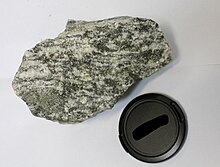TTG complex

Tonalite-trondhjemite-granodiorite complexes , TTG complexes or TTG suites for short , are typical of the archaic cratons . The oldest known TTG suite is located in the south of West Greenland and is 3.8 Ga old, TTGs still appear slightly changed until the Phanerozoic . They represent probably the first and oldest continental crust at all.
Chemical composition
TTG complexes consist of tonalites , trondhjemites and granodiorites , which are characterized by a particularly high sodium content, otherwise the term covers a wide field of chemical compositions.
Emergence
The formation of the TTG complexes is controversial and took place under different conditions than modern plate tectonics , probably until the end of the Archean (approx. 2.5 Ga) basaltic material (probably early oceanic crust ) was only pushed over but not deeply subducted . The TTG complexes could be the result of partial melting of this material. In the case of Isua Greenstone Belt there geochemical accordance with one occurring in the same unit older eoarchaischen tholeiite which therefore as a source rock is suspected. The same applies to the Pilbara TTG complex, where basaltic material occurs in the East Pilbara Terrane , which is assumed to be the parent rock of the nearby TTG complex, but does not appear to come directly from the Earth's mantle itself. At that time there was probably a rapid drainage of the oceanic crust due to the higher geothermal gradient, which is why it did not experience the metamorphosis that is common today to the substantially denser rock eclogite so quickly . As a result, the overturned oceanic crust initially had a lower density and could not be subducted deeper. Over time, the overturned crust experienced a strong warming, as a result of which a metamorphosis to amphibolite and eclogite as well as a partial melting took place. The melting must have taken place in the pressure-temperature stability field of garnet - i.e. at a depth of at least 40 km; Based on the current thickness of the oceanic crust, this corresponds to about four times the normal thickness. The classical archaic TTG complexes also lack indications of an interaction such as e.g. B. Foreign mineral inclusions or hydrothermal alterations of the magmas with earth mantle rock (peridotite) , in contrast to postarchaic TTG complexes or adakites . The more acidic magmas resulting from this partial melting and possible fractionation rose due to their lower density and intruded or erupted .
literature
- Martin Okrusch, Siegfried Matthes: Mineralogy. An introduction to special mineralogy, petrology and geology . 8th edition. Springer-Verlag, Berlin et al. 2009, ISBN 978-3-540-78200-1 .
- R. Taylor, S. McLennan: Planetary Crusts. Their Composition, Origin and Evolution . Cambridge 2009. ISBN 978-0-521-84186-3
Individual evidence
- ↑ Thorsten J. Nagel, J. Elis Hoffmann, Carsten Münker: Generation of Eoarchean tonalite-trondhjemite-granodiorite series from thickened mafic arc crust . In: Geology . February 28, 2012, ISSN 0091-7613 , p. G32729.1 , doi : 10.1130 / G32729.1 ( gsapubs.org [accessed April 1, 2017]).
- ^ Huaiyu Yuan: Secular change in Archaean crust formation recorded in Western Australia . In: Nature Geoscience . tape 8 , no. 10 , October 1, 2015, ISSN 1752-0894 , p. 808–813 , doi : 10.1038 / ngeo2521 ( nature.com [accessed April 1, 2017]).
- ^ A b Tim E. Johnson, Michael Brown, Nicholas J. Gardiner, Christopher L. Kirkland, R. Hugh Smithies: Earth's first stable continents did not form by subduction . In: Nature . tape 543 , no. 7644 , March 9, 2017, ISSN 0028-0836 , p. 239–242 , doi : 10.1038 / nature21383 ( nature.com [accessed April 1, 2017]).
- ↑ Thorsten J. Nagel, J. Elis Hoffmann, and Carsten Münker Generation of Eoarchean tonalite-trondhjemite-granodiorite series from thickened mafic arc crust Geology, G32729.1, first published on February 28, 2012, doi: 10.1130 / G32729.1
- ↑ MG Bjørnerud and H. Austrheim: Inhibited eclogite formation: The key to the rapid growth of strong and buoyant Archean continental crust. Geology, September, 2004, v. 32, p. 765-768, doi: 10.1130 / G20590.1